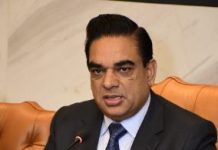DNA
LAHORE: The Ferozepur Road Industrial Association Lahore (FRIA) senior vice chairman Shahbaz Aslam has said that the economy throughout the 2023 continued to stuck in low growth trap, as economic conditions leave Pakistan highly vulnerable to climate shocks with insufficient public resources to finance development.
Shahbaz Aslam, who is the prominent business leader, while referring to the data of concluding year 2023 and media reports, suggested the domestic debt re-profiling did not always work unless associated with sharp and sustained structural reforms
The FRIA senior vice chairman advised the government to look at the bigger picture while cautioning domestic stakeholders that creation of a new institution that envisages billions of dollars of investment inflows backed by pledges may not provide a quick fix of the economy. This is not to undermine the concerted ongoing efforts to make Pakistan an attractive destination for foreign investment but to emphasise the fact that basic economic theory dictates that foreign investment would flow into those countries where the economy is strong, growth is projected to rise and key macroeconomic fundamentals, including foreign exchange reserves, are more than sufficient to forestall the possibility of inability to meet the import bill, which includes basic inputs/essentials for industry as well as the householder.
Shahbaz Aslam, who is also the PIAF executive committee member, said that structural reforms are therefore the way forward and until and unless the administration supplements its crackdown with these reforms that are minutely identified in reports but continue gathering dust in all relevant ministries, the situation is unlikely to lead to sustainable long-term improvement.
He said that the government is forced to borrow from the domestic and external resources to finance the fiscal deficit as the country’s tax revenue collection is insufficient to meet the expenditures. While, in absence of external financing the government is completely dependent on domestic borrowing, of which domestic debt stocks are sharply increasing. The multilaterals as well as bilaterals have long been urging the government of Pakistan to reform the power sector, since decades ago when circular debt was in millions of rupees which today is a whopping 2.5 trillion rupees, to reform the tax structure that continues to rely heavily on indirect taxes whose incidence on the poor is greater than on the rich, a major contributory factor in poverty levels reaching a high of 40 percent today, to continuing the policy of steadily raising the budgeted current expenditure, thereby shrinking the available fiscal space annually and, last but not least, warning Pakistan of an impending water scarcity decades ago that went unheeded resulting in the country’s current status of a water-stressed country.
He noted some home truths about the steady regression of key macroeconomic indicators due to resistance and reluctance to implement the necessary reforms by civilian and military dispensations that, in his words, accounts for the worst ever economic crisis in the country today. He referred to the stop and go cycles of half-hearted reforms that are just enough for the country to muddle through but that offer no long term perspective of improvement.

















